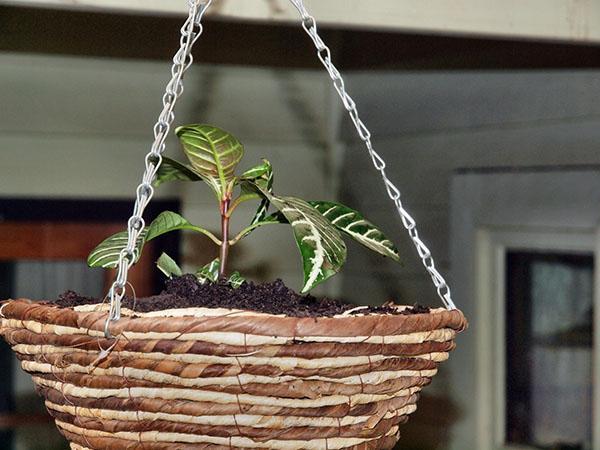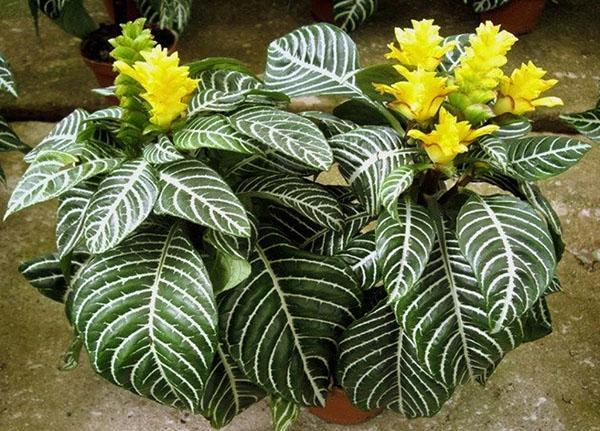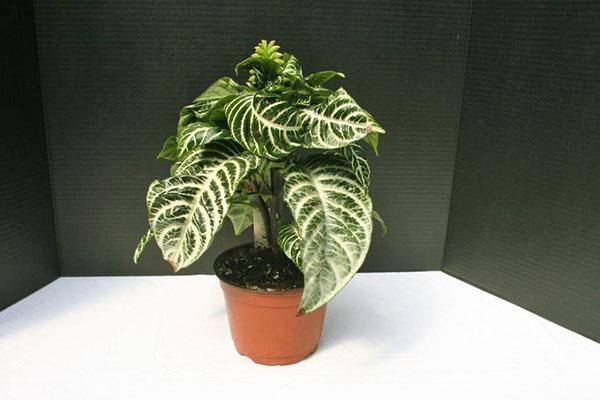Reproduction of afelandra at home
 Many amateur flower growers want to replenish their collections with beautifully flowering bushes of home Afelandra. Although a tropical plant as a pot culture is very moody and demanding to care for, it grows quickly, blooms and even sets seeds.
Many amateur flower growers want to replenish their collections with beautifully flowering bushes of home Afelandra. Although a tropical plant as a pot culture is very moody and demanding to care for, it grows quickly, blooms and even sets seeds.
Propagation of a flower of afelandra by cuttings

Benefits of propagating Afelandra using cuttings:
- relative simplicity;
- the rate of obtaining young viable plants;
- high survival rate of seedlings.
For rooting, apical cuttings at least 7-12 cm long with well-formed 2-3 leaves are suitable. The future seedling should be separated from the bush with a sharp knife just below the node. When the cut dries up a little, it is powdered with a rooting stimulator.
It is useful to treat the places of separation of the cutting and its base with charcoal or cinnamon powder crushed to a powder state. This will help disinfect the sections and prevent the growth of mold and putrefactive bacteria.
Cuttings are planted in moistened perlite and placed under a film or in a greenhouse. If there is no perlite, it can be replaced with a mixture of turf and sand, but such a substrate must be sterilized.
It takes about three weeks on average to root. In order for the process to go steadily and quickly, special conditions are created for young domestic aphelander:
- maintain the temperature within 24–26 ° C;
- provide partial shade or diffused light;
- do not allow the concentration of moisture in the air to fall below 90%;
- air the greenhouse with seedlings daily.
During the rooting of the cuttings of the Afelandra flower, they are recommended to be treated with a systemic fungicide after a week in order to avoid damage to the seedlings with leaf spot, which massively affects young plants and leads to their death.
 When the seedlings develop their own roots, they are transplanted into separate small pots with loose soil mixture, which is used to transplant adult plants.
When the seedlings develop their own roots, they are transplanted into separate small pots with loose soil mixture, which is used to transplant adult plants.
To become the owner of the young, as in the photo, Afelandras, cutting and rooting of cuttings is carried out from May to early September. In this case, the plants actively form the root system and do not get sick.
Reproduction of domestic Afelandra by seeds
 If, after flowering, seeds ripen in the place of inflorescences, then they can also become planting material. In this case, the reproduction of Afelandra at home is carried out in the fall.
If, after flowering, seeds ripen in the place of inflorescences, then they can also become planting material. In this case, the reproduction of Afelandra at home is carried out in the fall.
Seeds are embedded in a loose mixture of sand and peat, moistened and placed under a film. Germination takes place at a temperature of 22 ° C with constant humidity.
The grown seedlings are dived and then planted in separate containers with a drainage layer and a substrate for adult plants of domestic Afelandra.
Afelandra flower pests and growth problems
A native of the South American tropics, the afelandra flower attracts not only indoor floriculture lovers, but also all kinds of pests.
Most often, at home, plants suffer from scale insects, mushroom gnats, spider mites, mealybugs and nematodes that enter the ground if it has not been thoroughly disinfected and sterilized.
 Instances of Afelandra, as shown, taken out to the garden or balcony for the summer, can attract aphids, whiteflies and slugs. Therefore, it is very important to monitor the state of the room culture and establish prevention.
Instances of Afelandra, as shown, taken out to the garden or balcony for the summer, can attract aphids, whiteflies and slugs. Therefore, it is very important to monitor the state of the room culture and establish prevention.
The plant should be in conditions acceptable to it, receive regular watering and feeding. It is useful to irrigate the crown with clean warm water and treat leaves from dust.
At the first sign of insects, it is necessary to treat the homemade afelandra with an insecticide and continue the course until the traces of pests disappear.
Afelandra is not for nothing considered a rather capricious houseplant. At home, she can wither not only from the invasion of pests, but also from non-compliance with the conditions of detention. This is most often expressed:
- in changing the shape of the leaves, their deformation and shortening of internodes, which indicates excessive illumination of the bush and too high air temperature;
- in the mass death of foliage, and then shoots, which signals an excessively wet soil due to watering or a lack of drainage, as well as excessive fertilizing;
- in the wilting and dropping of foliage that has dried out due to too dry air in the room.
As a rule, these problems can be successfully solved if measures are taken in time and the humidity, temperature and light conditions are adjusted.
Diseases of domestic aphelandra
 The appearance of brownish or black spots on aphelandra leaves, as in the photo, may be a sign of the vital activity of the harmful fungi Myrothecium roridum and Corynespora. Both microorganisms cause damage to leaf tissue and their gradual death. To cope with the trouble will help three times the treatment of the plant with a systemic fungicide.
The appearance of brownish or black spots on aphelandra leaves, as in the photo, may be a sign of the vital activity of the harmful fungi Myrothecium roridum and Corynespora. Both microorganisms cause damage to leaf tissue and their gradual death. To cope with the trouble will help three times the treatment of the plant with a systemic fungicide.
They are carried out with an interval of 7 to 8 days, closely monitoring the state of the culture. As a preventive measure, falling leaves should be removed and the conditions for keeping afelandra should be observed.
If the plants are kept below the recommended temperature for a long time, the irrigation regime is not observed, or the afelandra flower lacks Sveta, you may encounter stem decay at the point of contact with the substrate. This is the result of the activity of bacteria of the species Botrytis, Phytophthora and Pythium SPP, which infect not only leaves and stems, but also the root system.
The rotted parts of the aphelandra must be removed, the cut sites must be treated with coal powder and the plant must be transplanted into a clean substrate. Subject to preventive measures and placing the pet in the proper conditions, the home Afelandra will again be covered with foliage, and will bloom in the spring.